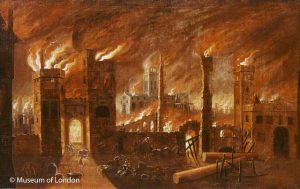
In advance of the Housing White Paper, we look back at the evolution of the building surveyor
This year marks the 350th anniversary of the passing of the London Building Act, which was a result of the Great Fire of London. The story of the Great Fire’s beginnings in Pudding Lane in 1666, and how it devastated vast swathes of the City, is well known. The Museum of London is currently hosting a major exhibition called Fire! Fire! where you can actually handle fire charred bricks. What is less well known is the effect the Great Fire had on London’s building regulations.
The Great Fire burned for four days and destroyed 13,200 houses and dozens of churches, including St Paul’s Cathedral. It was estimated that 70,000 of the City of London’s residents were made homeless – a staggering figure when you consider the City’s population was 80,000.
 The medieval city that burned down was a place of narrow alleyways and poorly built houses. It was dense and unhealthy – and it was only the year before that the Great Plague had struck the City’s populace. The majority of the houses were made of wood with wattle and daub infilled walls. Many jutted out from the upper floors over the alleys below so houses almost met on either side of the street. When you include jerry built extensions, lean-tos and the close proximity of trades, such as blacksmiths and bakers, to residential homes it is no surprise that the Fire took hold with such ferocity.
The medieval city that burned down was a place of narrow alleyways and poorly built houses. It was dense and unhealthy – and it was only the year before that the Great Plague had struck the City’s populace. The majority of the houses were made of wood with wattle and daub infilled walls. Many jutted out from the upper floors over the alleys below so houses almost met on either side of the street. When you include jerry built extensions, lean-tos and the close proximity of trades, such as blacksmiths and bakers, to residential homes it is no surprise that the Fire took hold with such ferocity.
Rebuilding started within days of the Fire being extinguished. Property owners didn’t pause to ponder the masterplans laid out by the likes of Wren, Evelyn or Hooke. Instead the new buildings rose on the same footprint as those that had been destroyed and so reintroducing the Medieval street pattern.
The London Building Act of 1667
There was one lasting legacy: The London Building Act of 1667. You could say all Party Wall Acts that came after are based on the 1667 Act. The new Act laid down new building regulations, such as all houses should be built of brick or stone and specified the thickness of walls for the first time. More importantly, the new regulations were enforced by building surveyors, not a new profession in the 17th century but one that was to become pivotal to the development of our towns and cities. Over the next 350 years building regulations may change but what has remained constant is the need to seek impartial and trusted advice from professional building surveyors.
